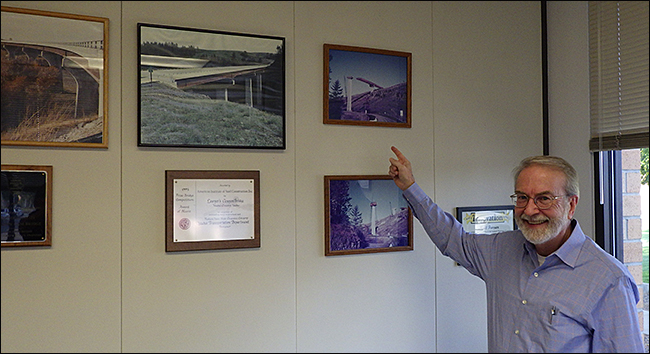

Farrar remembers "Biggest Diving Board in the West"
on 30th anniversary of Lawyers Canyon Bridge project

ITD State Bridge Engineer Matt Farrar had been working for the department’s Bridge section for just a few years back in late summer 1989, when he was tapped to design the new Lawyer’s Canyon Bridge connecting Idaho County to Lewis County in north-central Idaho.
As we near the 30th anniversary of the bridge project beginning (that next spring), Farrar shares some insights:
“The Lawyers Canyon Bridge definitely holds a special place in my heart. I got involved early on in the project and prepared several concepts for bridge types (arches, trusses and girders were considered) and materials before we decided on what is in place now.”
"The bridge has fairly long spans and the tall pier columns are hollow inside. The construction was very unique in Idaho and in the USA."
The bridge was the first in Idaho founded on drilled shafts. Shafts were drilled into the ground and reinforced with concrete. The thing was huge, built with 30,000 bolts, each a foot long, securing more than two million lbs. of steel. The curved girders were so massive and unpredictable that a windy day would halt work during the placement process.
"The four steel plate girders were 'launched' from either side rather than using a more traditional crane. Typically a bridge is assembled by cranes lifting the massive pieces into place. For a while during construction, I thought of it as the biggest diving board in the West!"
Note: The $4.5 million bridge, about 919 feet long and 46 feet wide, opened in late 1991. ITD won an Award of Merit for the bridge in the 1993 American Institute of Steel Construction Prize Bridge Competition. The bridge was built by Flatiron Structures of Longmont, Colorado, to replace the old wooden trestle bridge that followed the Camas Prarie Railroad line. It had been built in 1908 but abandoned in 2000.
Instead of building the bridge along the canyon wall, the new structure was built closer to the canyon rim to take advantage of sunshine that would melt ice and snow.
Pat Lightfield, who retired from D2 in early 2014, was the Resident Engineer on the project.

Published 09-13-19